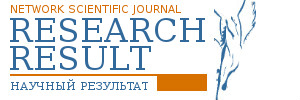GAMES AND PLAY: PATHS TOWARDS CHILDHOOD HUMANIZATION
Abstract
This paper aims at discussing games and plays and the way children perceive their realities throughout these dynamical processes. The theory of game activity was developed by D.B. Elkonin based on the psychological theories of interaction and language acquisition of L.S. Vygotsky. Caretakers and educators шт pre-school educational systems should understand the nature and importance of the play activity of children for the formation of their personalities. Playing is a manner for children to satisfy their needs in order to adapt themselves to social life. Playing is the way to understand reality and the relationship of students with reality. In other words, playing subsidizes childhood humanization. Here we assume the importance of pedagogical work with children within school and we problematize how education can contribute to the relationship between chil-dren and play, and how it can help the process of childhood humanization.
During the course of an individual development process, there is a transformation of the ways of relationship with the world, also changing the possibilities of appropriation of this world. At pre-school age (0–5 years), developmental period reflects the social place where children are at this moment of life, as well as their relationship with the world and with themselves. Play stands out as the main interaction type between children and the world, because this connection gives them the opportunity to appropriate of their realities. “The main activity of children in pre-school age is the game” [7, p. 152].
Famous Russian educator K.D. Ushinsky raised the importance of using games in education... He wrote: “Game - is a free activity of child, and if we compare the interest in the game, as well as the number and diversity of the traces left by the game in the child’s soul, with similar effects of teaching in the first four or five years, then of course all the benefits will be on the side of the game. It shapes all aspects of the human’s soul, mind, heart and will” [5, p. 7].
Playing is a manner for children to satisfy their needs in order to appropriate of social life, of behavioral means, of adult relationships and activities which are not directly accessible to children. During the game children want to act out as the adult do, because of this, their ludic actions correspond to adults actions. The distinguishing trait of playing is that it allows children to do actions without necessarily obtaining results.
Games are based on reality. Development of children “will evolve only through interaction with real surroundings and within the context of peer relationships” [3, p. 17]. The role acted by children in game is essential; it is a reference to their behavior. Playing role is a sign or a psychic tool that allows children to dominate their stimuli that go on themselves and so dominate their own behavior. Nascimento & Dantas exemplify that by using an image of playing in zoo. If a child takes on the role of an animal handler, she/he will attend all the real functions of an animal handler.
On the possibility for an educator to work pedagogically with playing, Nascimento & Dantas state: “Although children, in their daily actions, create games with protagonists, it is not denied the possibility of education to work pedagogically with games, that is, to work pedagogically with the main activity of children of pre-school age” [7, p. 152].
It is very important to continue using games and plays at elementary school, because “they play a significant role in physical and moral development of each child … The collective activity of younger shool pupils is necessarily permeated with games ” [9].
Play within the educational process, besides requiring intentional and explicit organization of an activity that will be appropriated by children, also requires the building of a specific way of educational process organization. According to Nascimento & Dantas, the way to pedagogically organize social activities to be appropriated by children is through usage of themes.
Themes are not simply a didactical resource or a more suitable technique to work with games for a pre-school age children. They are, first of all, a social tool to organize education. Game is an axis to understand reality and the relationship of students with reality. We assume that themes are a pedagogical way to work with children social activities within the school [7, p. 155]. Nascimento & Dantas are saying that working with themes in kindergarten is not equivalent with themes at school. It should not be only adding contexts to kinesthetic skills, but organizing cultural body reality which allows children to appropriate of this reality [7].
S. Rubinstein states that playing is one of the most transcendental phenomena of life. It can be seen as an inutile activity, however, despite being inutile it is very necessary. “For human beings, play is a son of work. This relation between play and work happens through the content of playing. Every play reproduces, in general, certain ways of practical activities” [8, p. 110]. Play is related to praxis, influencing the world. As the products of human activity, play transforms reality and changes the world.
Controlling a wider area of reality by children (not entirely accessible area) can be gained through the games. According to Araujo, Miguéis e Nascimento, in cultural-historical theory, game is assumed as an activity when people reconstruct social relations and, within this process, new psychic functions are constructed. Game is a peculiar human activity throughout which children develop themselves while appropriate social experiences built by humankind. “The basis of play/game is social because of its origin, that is, play/game is born within children’s life conditions in society” [1, p. 36-37]. It means that game reconstructs reality in a single way. People’s norms are redone by singular means more explicitly in people’s consciousness, via symbolic situations. This way, game has its function which is to permit children to understand the world of human relations and adults activities in order to humanize.
Play comes from the contact with the world and it depends on all reciprocal human relations where children are also immersed. According to Rubinstein, the activity in play is an activity with an immediate interest basis, not a utile effect: “Play is the way how children’s necessities and requests happen within their possibilities” [8, p. 114]. Through the game children comprehend the world around them. As stated by L. Vygotsky, playing creates a zone of proximal development on children. This way, they often behave beyond their actual age. “In an imaginary situation, the creation of voluntary efforts and plans for real life – everything is in the activity of playing, which is the highest level of pre-school children development” [10, p. 135].
Play is not a mere operating system that mature in the body, not even a movement that occurs because of the accumulation of energy. Some theories yet consider the existence of a childish nature for games. Those theories are frequently related to kindergarten background. As said by Araujo, Miguéis & Nascimento, it is a false idea, because games are not a reality for children since ever. They came up after a human phylogenic process. Elkonin states that “in an underdeveloped society with a primitive community organization work, children go into adult productive labor very early, taking part of it along with their potentials” [2, p. 56].
The connection between children and adult work make stronger this linking with society. In the words of Elkonin, “on that social development level and with that status, children didn’t need to reproduce work neither to establish special relationship with adults, they didn’t need a game with protagonists” [2, p. 60]. It is in a complexification process that children’s work, concomitantly, moves the complicated spheres of adult’s work into more and more reduced activities.
According to A. Leontiev, the fantasy, which is intrinsic to children, is also engendered in play. “Children don’t imagine with the purpose of playing, but in the process of playing they imagine” [6, p. 296]. In order to do actions and operations inherent to adult world, children organize various substitutions, like using accessible objects and places to act: any plate can be a steering wheel; any room can be an office. Children want, themselves, to drive a car, to row a boat, but they cannot do that obviously because they don’t master the operations required by real objective contradictions of these given actions [6, p. 121]. Any education is intrinsically national according to K.D. Ushinsky, and it is best done in the child’s native language and with the use of this nation’s culture,which is also expressed with ethnic games, folklore plays and traditional toys. These aspects of education are studied by ethnopedagogy. “Ethnopedagogy examines the process of social interaction and social influence in which to educate, develop personality, assimilate social norms, values and practices; collects and organizes the folk knowledge about the education and training of children, folk wisdom, as reflected in the religious teachings, tales, legends, epic parables, songs, riddles, proverbs and sayings, games, toys, etc.” [4, p. 8].
Lastly, if we accept that the objective adult world is not accessible to children, play and games will assume a specific and important role in this human development process. Playing is a fundamental activity in the children’s education; it is the best activity to institute the relation ‘children-world’, allowing the appropriation of historically produced cultural productions.
The great amount of human objects challenges children with problems to be solved. Those objects appear to children naively. Human aspects arise for children as human acts towards those objects. Our task as educational workers is, thus, trying to focus on the work with themes in the educational environment through the perspective we have presented in this paper. We should remember that our main goal is to contribute to children’s development in the process of understanding themselves and the world around them.

















Reference lists